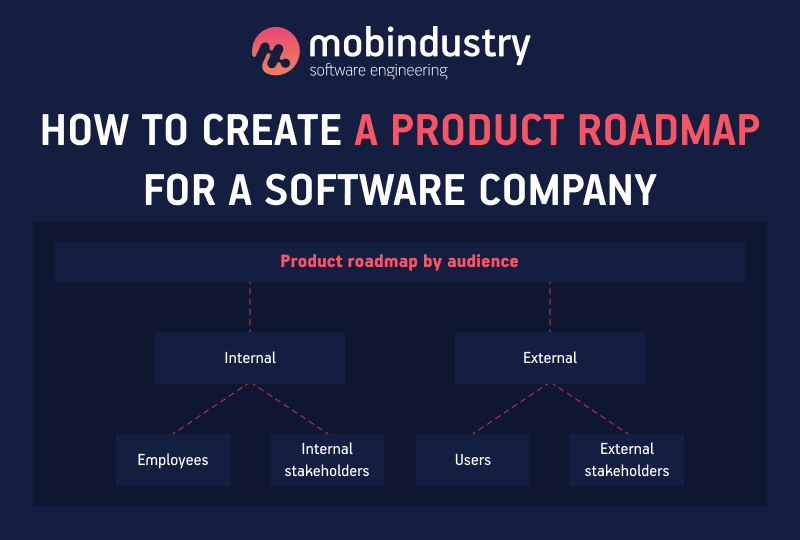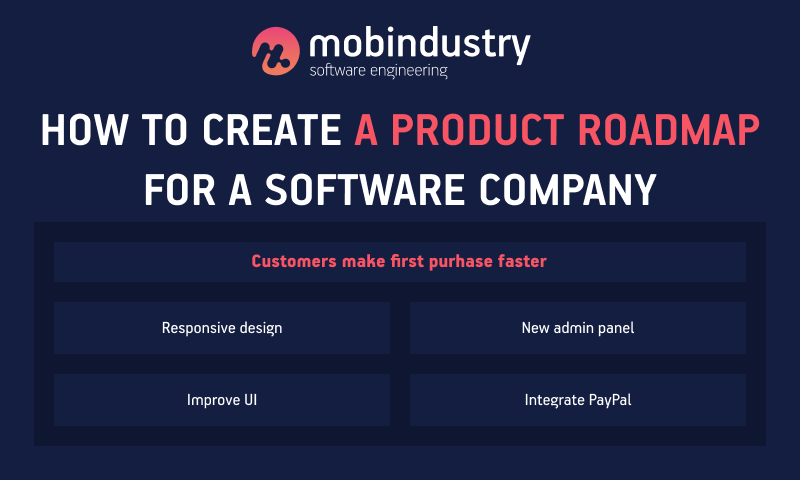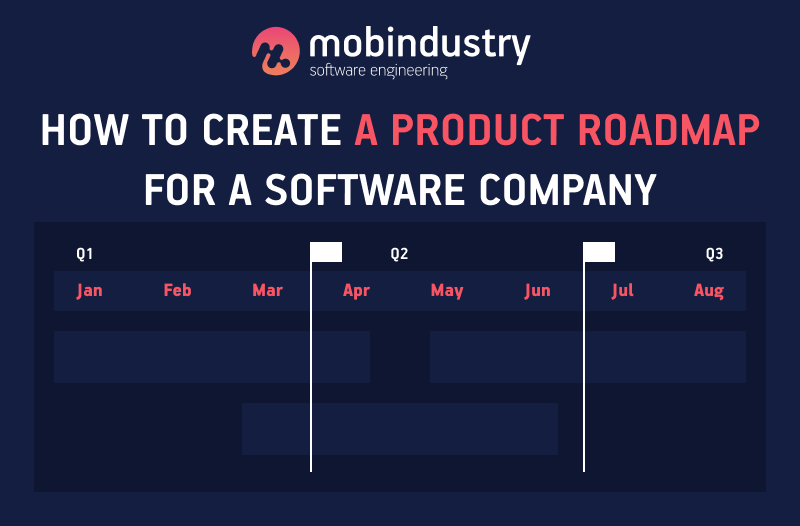How to Create Product and Technology Roadmaps for Your Tech Startup
In this article, we go into the details of how to create product and technology roadmaps and the differences between them.
What is a product roadmap?
A product roadmap is a visual, step-by-step map of product development. It can include upcoming features, list technical considerations, and show how the product will evolve over time. A roadmap often looks like a smart card, only for strategic planning. Product roadmaps help managers plan tasks by time and milestones, create task dependencies, and check task statuses throughout the project.
What is a technology or IT roadmap?
A technology roadmap is a document that visualizes your goals, initiatives, and improvements that will help you grow into a high-performing IT organization.
It allows you to visualize and balance work of different sizes and types, solving problems of technical debt, basic infrastructure, and growth-oriented innovation. Determining why, what, and when before starting on the how will help you focus on the big picture and the value you provide to both internal and external stakeholders.
How a technology roadmap differs from a product roadmap
Technology roadmaps differ from product roadmaps in one major respect: While a product roadmap communicates strategic plans that will affect how a company interacts with its customers and the market as a whole (through new product launches and feature updates), a technology roadmap communicates plans that will directly affect only a company’s internal systems and processes.
In fact, some companies even share their product roadmaps with the public. In contrast, the audience for a technology roadmap is almost always exclusively internal, such as the IT department itself, the operations department, and company leaders.
What is included in a technology roadmap?
Every company has unique needs. You can customize your technology roadmap to suit your needs and your audience. Technology roadmaps usually include a combination of these key components:
Goals and initiatives represent what you hope to achieve with technology solutions. Specifically, they focus on the business opportunities technology provides and what will be required to support that technology in the future. Initiatives are great work topics to help you achieve your goals.
New system capabilities improve technology systems. For example, adding customer asset tracking to a CRM system can help you better understand multiple business units.
Release plans focus on improving systems to support new capabilities your business needs. Releases are usually predictable and are planned months in advance. They’re also widely distributed throughout the organization.
Milestones are key advances in technology development. Milestone tracking allows stakeholders using systems to understand progress toward a long-term goal throughout the project.
Milestones are usually tied to specific dates and are considered performance targets to ensure the organization is on the right track.
Resources detail the people needed to implement and maintain systems. IT departments should plan to roll out new features concurrently and update legacy systems as needed. This creates cross-functional dependencies between teams.
Training explains the type of guidance the internal team needs to support the system for real users. Training can be applied to a new system being introduced for the first time or to improvements to an existing system already in widespread use.
Risk factors represent internal and external barriers that can prevent an organization from achieving goals and milestones specified in the technology plan. These can include limitations of the technology itself as well as broader market conditions that pose challenges to the organization.
Status reports are an important and necessary part of the technology roadmap to keep everyone informed. Delaying the implementation of one core system will affect the plans of business units that depend on it. For example, an enterprise that implements a new partner discount plan for its channel cannot continue to operate until systems are updated to work with the new discount structure.
What should a product roadmap include?

Companies create product roadmaps for two types of audiences: external (investors, customers) and internal (product groups). You might even want to create two different roadmaps (or different versions of one roadmap):
- For investors and clients, a roadmap shows what you are going to do and how you are going to do it. It should be simple and visually appealing.
- For employees, a roadmap makes sure everyone is on the same page. This type of roadmap is usually more detailed.
These are some things that most roadmaps include:
Time horizons
Whether your roadmap will cover a month or a year depends on your product and your goals. For example, you might want to show investors a timeline spanning a year, while you’re better off showing employees a monthly timeline. Better not to marry yourself to specific dates. Priorities may change, or you may face a problem that takes months to resolve.
Examples of timelines:
- Aug, Sep, Oct, Nov
- Now, Next, Later
- Q1, Q2, Q3
Milestones
By checking if your team is up to the milestones, you can stay on track and make sure your roadmap remains a useful and up-to-date document.
Themes
In product management, a “theme” refers to a high-level strategic goal. For example, for an ecommerce website, you might want customers to make their first purchases faster. Or you may want your healthcare app to be HIPAA compliant.
Here are a few examples of themes:
- Improving software for team communications
- Launching a business intelligence analytics dashboard
- Increasing the number of monthly users by 10%

Epics
An epic is a group of features or user stories with a common purpose. You will have multiple epics for each theme and multiple stories/features for each epic. For example, to get customers to make their first purchases faster (your theme), you may need to add the Credit Card Processor API (an epic) or improve the UI/UX design (another epic).
Stories
A story is a group of specific steps to achieve a goal. This is one of the more detailed sections where you need to specify exactly what will be done. In the example of your healthcare app, completing the HIPAA epic may require some outside work. For example, you may need to create a 2FA check or implement other security measures.
Features
Features are the most detailed elements of a product roadmap and can also be seen as tasks.
Examples of features:
- Implement single sign-on authentication
- Integrate PayPal
- Share saved video files
Types of product roadmaps
Let’s take a quick look at popular types of product roadmaps:
Type #1. Timeline-based
A timeline-based product roadmap answers the question How long are you going to focus on a specific task and when are you going to complete it?

The main reason for adding a timeline to a product roadmap is to give stakeholders a complete picture of when and in what order you will do things. Sometimes, companies don’t set exact dates because they don’t want to be tied to deadlines. The time frames are kept at a high level: several months, a quarter, a year.
Type #2. Roadmap with no dates
When you’re writing a product roadmap for customers or your sales and marketing teams, it’s often best to focus on topics and strategies rather than dates or deadlines.
In this way, you earn people’s interest in the upcoming product without having them waiting for the release day. You probably don’t want to risk your reputation by giving your customers a release date, as they’ll be disappointed in the event of a delay.
Type #3. Kanban roadmap
Planned and undated roadmaps are usually for a long period of time, such as months or even years. In contrast, a Kanban roadmap focuses on what needs to be done right now.

Kanban gives a high-level view of a project, primarily for an internal audience — developers, product teams, and others responsible for product development.
You can use statuses for your Kanban roadmap:
- Approved
- Validated
- Ready for estimation
- In progress
- Ready
This will keep your stakeholders informed of the status and priorities at each stage of development.
How to design and plan a technology roadmap
No two technology roadmaps will be exactly the same, as they depend on many factors. For example, scaling your business up and down involves two different approaches:
-
When downsizing during a crisis, the aim is to preserve as much operating infrastructure as possible to avoid critical losses. To this end, an IT roadmap will help you assess the importance of your IT assets and initiatives and show you where to focus your efforts.
- Scaling is a different matter entirely, as you have to focus on creating a solid foundation for continuous growth. How you achieve this goal will depend on your industry, type of company, level of product maturity, etc. The goal is to solve the unique problems you face and maximize your potential profit.
Once you’ve chosen a direction for your company, the rest of the steps in creating your roadmap are pretty simple.
Base your decisions on data
Fortune telling is for the Middle Ages. In the 21st century, the CIO has a huge amount of data at his or her disposal:
- Historical data on gross and net revenues: monthly, quarterly, annually
- Financial estimates for the next year or so
- Resource usage statistics
- Current storage capacity, arrival rate, and expected time to exceed the current capacity
- Current infrastructure speed and performance
This list is not exhaustive, and other interested parties can add to it. The goal when creating an IT roadmap is to foster a productive dialogue between all business units and ensure that IT goals are aligned with those of the company.
Designing a technology roadmap: Describe where you plan to go
A roadmap is essentially a timeline with the current IT situation on the left and the goal you want to achieve in 18 months on the right. Break your long-term goal into shorter tasks, assign them to people, and you’re done! To be successful in implementing an IT roadmap, you should consider several factors:
Mergers and acquisitions
Whether your company becomes part of a larger structure or inherits digital assets from a smaller partner, you’ll need to adjust your technology roadmap in response to a merger or acquisition.
New tools and technologies
The SaaS market is constantly evolving, and a tool that was the crème de la crème a year ago may now be a poor choice. As you’re on your way toward your 18-month goal, check your current situation and explore alternatives. Quarterly roadmap revisions are useful for aligning your goals with your business strategy.
Policies and procedures
Do you have an automated disaster recovery solution? Will you need new clients in the near future? The answers to these questions are helpful in developing policies and procedures that affect all of your workflows.
Scalability
You should build your roadmap with scalability in mind and should revise it regularly. Do you need more scalability than your current toolbox can handle? Maybe it’s time to replace poorly scalable tools.
Working with external consultants
Many companies choose to work with outside consultants to avoid mistakes. Whether you use them to assess your current infrastructure or delegate ad-hoc tasks to them, ’working with consultants can lead to better results across your entire roadmap. When choosing consultants, look for recognized certifications, a wide range of supported technologies, and clear communication to get the most out of your partnership.
How to build a product roadmap
Step #1. Vision comes first
Your product vision clarifies why you’re bringing your product to market in the first place and what its success will mean for the world and for your organization. For example, the vision of the Google Search product is “to provide access to the world’s information in one click.”
Start by realizing your high-level vision. From there, you can set goals: specific, short-term, up to a year, and with clear metrics (like getting 1,000 customers by the next quarter, or getting $100,000 from direct sales).
You can use Jeffrey Moore’s Value Proposition Template to craft your own product vision:
- For: [target customer]
- Who: [target customer’s needs]
- The: [product name]
- Is a: [product category]
- That: [product benefits/reason to buy]
- Unlike: [competitors]
- Our product: [differentiation]
Step #2. Tailor the roadmap to your audience
Remember: You should first create a roadmap for the product that you want to share. It’s useless if stakeholders, programmers, customers, marketers, and sales reps can’t access your roadmap.
Make your roadmap available to people working on the project and check it regularly so you don’t miss any updates.
It’s a good idea to tailor the roadmap to each audience:
- Investors. Focus on metrics like quarterly or monthly revenue and growth.
- Clients. Focus on the benefits of the product and the problems it solves. Don’t overload the roadmap with details. It should be simple and visually appealing.
- Developers. Focus on technology-related content: epics, user stories.
- Sales representatives and brands. Focus on customer benefits and product features (be careful with timing, though).
Step #3. Split themes into epics and user stories (if required)
Themes such as “improve website performance” or “make your application HIPAA compliant” are too vague for a development team to use.
It’s a good idea to break them down into epics or even smaller user stories that can be implemented over the course of a two- to four-week sprint.
You can then group user stories into categories based on business or technology similarities. After these stories are ready, imagine how users will interact with your app or website and what they might need.
Step #4. Choose roadmapping software
You can create a product roadmap using software you already have, such as Google Sheets, PowerPoint, or Excel.
But there are several roadmapping tools that can speed up the process:
- Aha!
- ProductPlan
- Roadmunk
- Jira
Step #5. Prioritize
Start by identifying the main themes and placing them on your roadmap. If you’re using dedicated roadmapping software, you can move topics with a few clicks or drag and drop to change their priority.
Once you’ve added the main themes, you can move to overlaying epic elements and specific features. But don’t overload your new product roadmap with every epic and user story. It’s better to prioritize user stories in the backlog.
Step #6. Add a timeline
Once you’ve placed your themes and epics on your roadmap and prioritized them, it’s time to plan your first release. Not all roadmaps have specific dates, but even if they do, those dates may change.
Place themes and epics on a new timeline to visualize the planned development process, especially if you’re working in an Agile environment. Don’t stick to deadlines you can’t meet, and avoid implementation details. As we said, the roadmap is not set in stone. Competitor actions, priorities, or resource changes can force you to change your product development or release schedule.
Final thoughts
Creating a roadmap for your product, your IT department, or your entire business is doable. Base it on your estimates of the future scale of your company, make data-driven decisions based on input from key stakeholders, and regularly review your roadmap to ensure your goals are relevant and are aligned with your business strategy.
If you want to create a product roadmap but don’t know where to start, contact Mobindustry for a free consultation.

